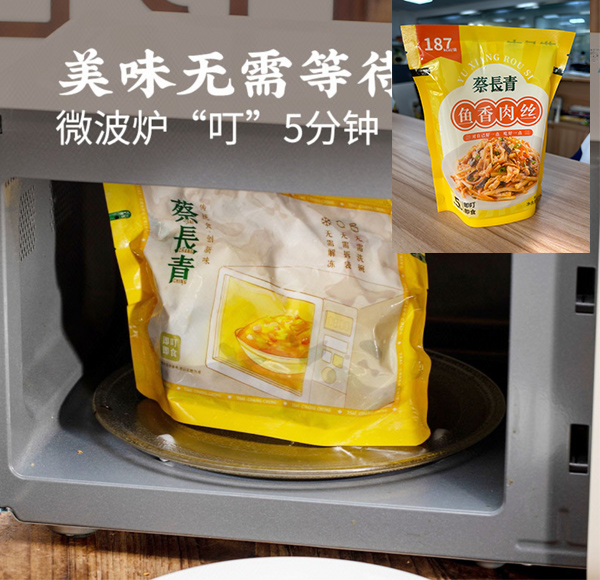PACK MIC has developed many new products in the field of prepared dishes, including microwave packaging, hot and cold anti-fog, easy-to-remove lidding films on various substrates, etc. Prepared dishes may be a hot product in the future. Not only has the epidemic made everyone realize that they are easy to store, easy to transport, easy to handle, convenient to eat, hygienic, delicious and many other advantages, but also from the current consumption perspective of young people. Look, many young consumers who live alone in big cities will also embrace prepared meals, which is a rapidly growing market.
Prefabricated dishes are a broad concept that involves many product lines. It is an emerging application field for flexible packaging companies, but it remains true to its roots. The requirements for packaging are still inseparable from barrier and functional requirements.
1. Microwaveable packaging bags
We have developed two series of microwaveable packaging bags: one series is mainly used for burgers, rice balls and other products without soup, and the bag type is mainly three-side sealing bags; the other series is mainly used for products containing soup, with bag type Mainly stand-up bags.
Among them, the technical difficulty of containing soup is very high: first of all, it must be ensured that during transportation, sales, etc., the package cannot be broken and the seal cannot leak; but when consumers microwave it, the seal must be easy to open. This is a contradiction.
For this reason, we specially developed the inner CPP formula and blown the film ourselves, which can not only meet the sealing strength but also be easy to open.
At the same time, because microwave processing is required, the process of venting holes must also be considered. When the ventilation hole is heated by microwave, there must be a channel for steam to pass through. How to ensure its sealing strength when it is not heated? These are process difficulties that need to be overcome one by one.
At present, packaging for hamburgers, pastries, steamed buns and other non-soup products has been used in batches, and customers are also exporting; the technology for the soup-containing series has matured.
2. Anti-fog packaging
Single-layer anti-fog packaging is already very mature, but if it is to be used for packaging pre-made dishes, because it involves functional requirements such as freshness preservation, oxygen and water resistance, etc., multi-layer composites are generally required to achieve functionality.
Once compounded, the glue will have a great impact on the anti-fog function. Moreover, when used for pre-made dishes, a cold chain is required for transportation, and the materials are in a low temperature state; but when they are sold and used by consumers themselves, the food will be heated and kept warm, and the materials will be in a high temperature state. This alternating hot and cold environment places higher requirements on materials.
The multi-layer composite anti-fog packaging developed by Tomorrow Flexible Packaging is an anti-fog coating coated on CPP or PE, which can achieve hot and cold anti-fog. It is mainly used for the cover film of the tray and is transparent and visible. It has been used in chicken packaging.
3. Oven packaging
Oven packaging needs to be resistant to high temperatures. Traditional structures are generally made of aluminum foil. For example, many of the meals we eat on airplanes are packaged in aluminum boxes. But aluminum foil wrinkles easily and is invisible.
Tomorrow Flexible Packaging has developed a film-type oven packaging that can withstand high temperatures of 260°C. This one also uses high-temperature resistant PET and is made of a single PET material.
4. Ultra-high barrier products
Ultra-high barrier packaging is mainly used to extend the shelf life of products at room temperature. It has ultra-high barrier properties and color protection properties. The appearance and taste of the product can remain stable for a long time, making it easy to transport and store. Mainly used for packaging normal temperature rice, dishes, etc.
There is a difficulty in packaging rice at room temperature: if the materials for the lid and cover film of the inner ring are not selected well, the barrier properties will be insufficient and mold will easily develop. Rice is often required to have a shelf life of 6 months to 1 year at room temperature. In response to this difficulty, Tomorrow Flexible Packaging has tried many high-barrier materials to solve the problem. Including aluminum foil, but after the aluminum foil is evacuated, there are pinholes, and it still cannot meet the barrier properties of rice stored at room temperature. There are also materials such as alumina and silica coating, which are not acceptable either. Finally, we chose an ultra-high barrier film that can replace aluminum foil. After testing, the problem of moldy rice has been solved.
5. Conclusion
These new products developed by PACK MIC flexible packaging are not only used in the packaging of prepared dishes, but these packages can meet the requirements of prepared dishes. The microwaveable and ovenable packaging we have developed are a supplement to our existing product lines and are mainly used to serve our existing customers. For example, some of our customers make condiments. These new packaging with high barrier, dealuminization, high temperature resistance, anti-fog and other functions can also be applied to condiment packaging. Therefore, although we have invested a lot in developing these new products, the applications are not limited to the field of prepared dishes.
Post time: Jan-30-2024




